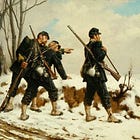The Hunted Hunters
German Jäger Battalions (Part VI)
In 1874, 469 battalions of foot troops - 442 of ordinary infantry and 27 of Jäger - served in the peacetime armies of the German Empire. By 1902, the number of infantry battalions had grown to 682 (an increase of more than 37%), but the number of Jäger battalions had dropped to 18 (a decrease of 33%.) To make matters worse, military journals often published articles calling for the abolition of the Jäger as a separate branch of service.
During the quarter century leading up to the outbreak of the First World War, the Inspectorate of Jäger and Schützen responded to the danger of organizational extinction by seeking new roles for Jäger battalions. One of the earliest of these was the provision of Jagdkommandos, ‘hunting commands’ capable of conducting long-range raids. Another was experimentation with machine guns and bicycles. (Where the Jagdkommando initiative competed with cavalry units, creating horse-drawn machine gun batteries and companies mounted on bicycles provided cavalry divisions with the capabilities that enhanced their ability to operate as independent formations.)
In addition to this, Jäger units experimented with things that promised to improve their traditional capabilities. These included self-loading rifles (such as the one invented by General Manuel Mondragón of the Mexican Army) and scout dogs.
The entrepreneurial strategy of the Inspectorate of Jäger and Schützen succeeded in preserving the place of the Jäger battalions in the armies of the German Empire. Better yet, it created a new, and explicitly modern, identity for a type of unit that had previously struck many observers as an anachronism. Thus, in turn, led the addition of two companies - one armed with machine guns and the other mounted on bicycles - to the four traditional companies of most Jäger battalions.
Sources:
Dagobert von Rentzell Geschichte des Ostpreußischen Jäger Battalions Nr. 1 (History of the 1st East Prussian Jäger Battalion) (Berlin: E.S. Mittler, 1882) pages 14 and 15
Peter Hofschröer Prussian Light Infantry, 1792-1815 (London: Osprey, 1984)
Curt Jany Urkundliche Beiträge und Forschungen zur Geschichte des Preußischen Heeres (Berlin: E.S. Mittler, 1901)
Curt Jany Geschichte der Preußischen Armee bis zum Jahr 1807 (Berlin: Karl Siegesmund, 1929) Volume 3
Peter Paret Yorck and the Era of Prussian Reform (Princeton: Princeton University Press, 1966)
The links will take you the websites of Osprey Publishing, the Hathi Trust, the Internet Archive or the Kujawsko-Pomorska Digital Library.
For Further Reading:







